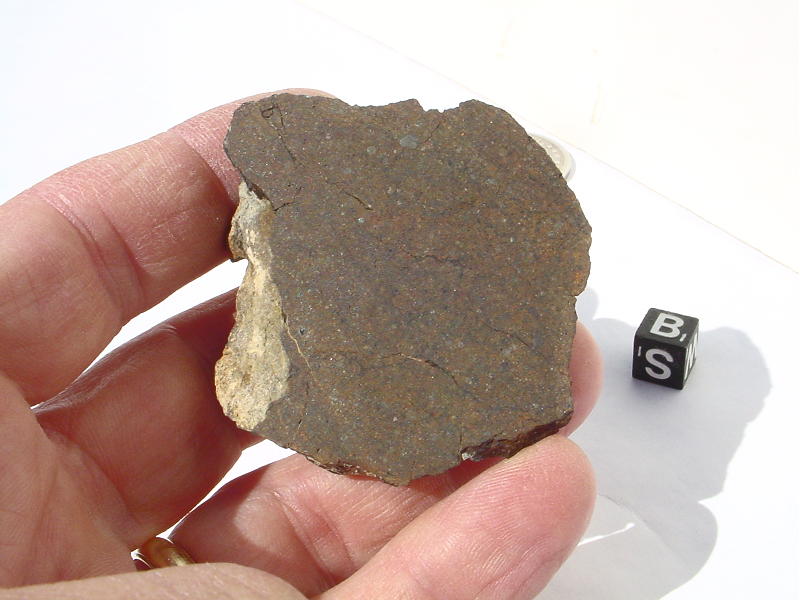Nevada Meteorite Picture of the Day [Month]
Previous "Pictures of the Day" can still be accessed at the NV Met PODs Archives!
The NEXT "Picture of the Day" will be POSTPONED until next month. I apologize for any inconvenience. But, in the meanwhile, I will continue to accept any images or photos of any Nevada meteorites for submission to "Nevada Meteorite Picture of the Day". Your contributions are always appreciated.
Discover the Solar System - right here in the Nevada desert!
Each day a different image or photograph of a NEVADA meteorite will be featured, along with a
brief explanation written by a meteorite-recovery expert.
2004 February 29

Name of Nevada Meteorite: NOT Formally Approved, YET - but a provisional name has been assigned.
Classification: (done by Planetary Studies Foundation) - Ordinary Chondrite ( H4 S4 W5 )!
Credit: Image taken by Robert Verish, on February 29, 2004.
Explanation:
The above image shows me holding an "endcut" of a chondritic stony meteorite sent to me by the finder. This particular stone was featured in a previous Nevada Meteorite Picture of the Day (NMPOD), and was depicted on the left side of that image!
The finder sent this sample to me because he heard from a fellow gold-nugget hunter (who had found a similar-looking meteorite) that I can get meteorites classified and that I could help get a name approved for his meteorite find. Which is true, because I just got back the clasification for that earlier find: Stony - Ordinary Chondrite ( H4 S4 W5 )!
After close examination of the later find, there is little doubt that the two will be PAIRED!
With luck, this has the potential to be a new Nevada strewn field!
But, getting these chondritic stones catalogued has been placed "on hold", since it has been brought to my attention that, starting back in 1999, a major university has had an "EMBARGO" placed on this locality being used as a meteorite name, and hence, on the publication of any paper about this meteorite locality. It appears that I have unknowingly started to conduct a study in an area that was already under investigation by academia. I will honor this university's senior status at this locality, and defer to the decisions of their principal investigator. As it stands now, out of the four (4) chondritic stones (that I know of) found at this locality, I have the GPS coordinates for three (3) of them, and classifications for the last two (2) of these. I will make this information available to the principal investigator, as well as any other data that would be of interest to them.
Nevertheless, I will continue my meteorite-recovery efforts at this locality, and to get classifications for any and all finds.
Given the above classification/weathering grade, this stone is a good candidate for 14C terrestrial age-date testing. Samples are available for just such a test.
In addition, a sample has already been submitted for measuring the following cosmogenic radionuclides:
41Ca (half-life = 1.04x105 yr), 36Cl (3.01x105 yr), 26Al (7.05x105 yr), 10Be (1.5x106 yr), and 53Mn (3.7x106 yr)
This stone is anticipated to have a very high terrestrial age!
I would like to take this opportunity to thank the finders of these meteorites for taking time from their gold-prospecting endeavors to make the effort to have their finds classified and cataloged. It is with distinct pleasure that I was able to help them obtain classifications for their finds. And, I would be honored to do this again for any of their future meteorite finds. In additon, if the "EMBARGO" status can be resolved, I will follow through with my promise to have their meteorites cataloged for all posterity.
A 1 centimeter cube-scale can be seen to the right of the stone in this image.
(Scale: cube is 1cubic cm)
Tomorrow's picture: POSTPONED - until next month.
<
| Archive
| Index
| Search
| Calendar
| Glossary
| Education
| About NvPOD
| >
Authors & editors:
Robert Verish
(M-Recovery)
